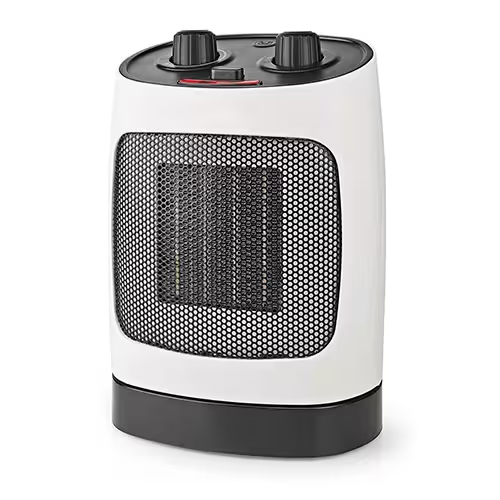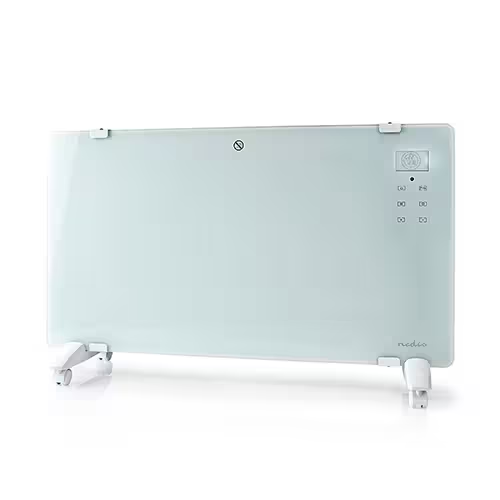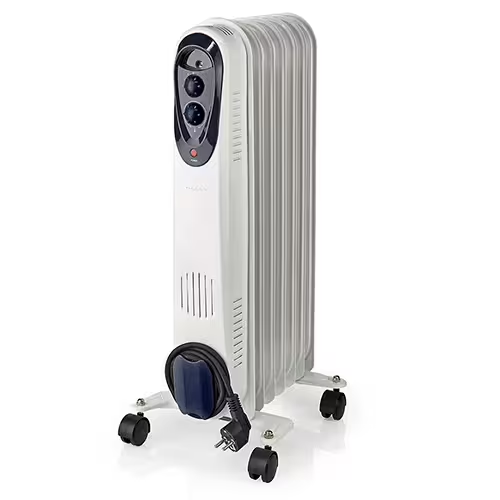22 Article
 Ceramic fan heater, 500 watts, adjustable thermostat, W 15.5 cmDelivery 2-3 days
Ceramic fan heater, 500 watts, adjustable thermostat, W 15.5 cmDelivery 2-3 days Industrial fan heater, 2 levels + cold level, 1000/2000!Delivery 2-3 days
Industrial fan heater, 2 levels + cold level, 1000/2000!Delivery 2-3 days Convection heater, white, remote control, timer, 3 levelsDelivery 2-3 days
Convection heater, white, remote control, timer, 3 levelsDelivery 2-3 days Ceramic tower heater, 1400/2000 watts, remote control, H 50 cmDelivery 2-3 days
Ceramic tower heater, 1400/2000 watts, remote control, H 50 cmDelivery 2-3 days- Ceramic fan heater, 2 levels, oscillating, W 15 cmDelivery 2-3 days
- Fan heater, 2 levels, cold air function, white, H 25 cmDelivery 2-3 days
- Ceramic fan heater, 2 levels, adjustable thermostat, W 15 cmDelivery 2-3 days
- LED bulb, silver, filament, transparent, H 10.6 cmDelivery 2-3 days
- Fan heater, 2 levels, adjustable thermostat, W 21.5 cmDelivery 2-3 days
- Industrial fan heater, 2 levels + cold level, 1000/2000 W, H 31 cmDelivery 2-3 days
- Oil radiator, electric heating, mobile, thermostat, trip protectionDelivery 2-3 days
- Convection heater, white, remote control, timer, 2 stagesDelivery 2-3 days
- Ceramic fan heater, 2 levels, movable, H 23.5 cmDelivery 2-3 days
- Oil radiator, electric heating, mobile, thermostat, trip protectionDelivery 2-3 days
- Ceramic fan heater, 2 heat settings, cold setting, W 20 cmDelivery 2-3 days
- Oil radiator, electric heating, mobile, thermostat, trip protectionDelivery 2-3 days
- Ceramic fan heater, 2 levels, oscillating, W 20 cmDelivery 2-3 days
- Electric heating, 3 levels, adjustable thermostat, L 52.5 cmDelivery 2-3 days
- Fan heater, 2 levels, cold air function, H 25 cmDelivery 2-3 days
- Oil radiator, adjustable thermostat, 3 levels, castors, H 62 cmDelivery 2-3 days
- Convection heater, black, 2 levels, turbo function, W 60cmDelivery 2-3 days
- Convection heater, white, remote control, timer, 2 stagesDelivery 2-3 days
Heating appliances - efficient heating solutions for every room
Whether in the living area, bathroom, office or workshop - warmth ensures cosiness. Modern heating appliances create a pleasant room climate in a short space of time. They offer mobility, easy handling and are ready for immediate use. However, not every heating appliance is suitable for every situation. Keeping an overview of heating systems makes it easier to make the right decision.
What heating systems are there? - An overview
Not every heater works in the same way. Behind the compact housings are different technologies with their own strengths and areas of application.
Electric fan heaters - for quick heat: Electric fan heaters use heating wires that are heated by electricity. An integrated fan distributes the warm air in the room. This type of heating is ideal when heat is needed quickly for a short period of time. Thanks to their compact size, fan heaters can be positioned flexibly - even in the bathroom or children's room.
Ceramic heaters - efficient and durable: Ceramic heaters belong to the group of fan heaters, but work with ceramic heating elements instead of wire coils. This technology offers greater efficiency and a longer service life. At the same time, the housing remains cooler - a clear safety advantage. The air heats up evenly, which makes the room climate pleasant. advantage: Ceramic heaters are also suitable for people with sensitive respiratory tracts as they stir up less dust.

Convection heaters - unobtrusive and quiet: Convection heaters draw in cool air, heat it internally and release it upwards. The natural air circulation ensures even heating - without any noise. Convectors are particularly popular as additional heating in the bedroom or office.
Tip: Many models can be mounted on the wall to save space.

Oil radiators - store heat sustainably: Radiators store heat by means of a heat-conducting oil inside. They continue to emit heat for a long time after being switched off. These appliances provide a quiet, long-lasting radiant heat - comparable to a classic radiator.
Advantage: Ideal for rooms where an even temperature is required.

Industrial fan heaters - powerful for large rooms: Industrial fan heaters are used where large areas need to be heated quickly: Workshops, construction sites or large warehouses. They work with high-performance fans and have a robust design. The output is usually significantly higher than standard household appliances - often between 3,000 and 9,000 watts. Thanks to their sturdy housing and carrying handles, they can be transported flexibly.
Please note: Some models require a power connection - ideally check beforehand whether this is available.
How many watts does a room need? - The rule of thumb for heat output
The right heat output depends on the size of the room. The rule of thumb is
- Around 100 watts per square metre of living space
A few examples for orientation:
Room size | Recommended output |
|---|---|
10 m² | approx. 1,000 watts |
15 m² | approx. 1,500 watts |
20 m² | approx. 2,000 watts |
30 m² | approx. 3,000 watts |
More power may be required for old buildings or poorly insulated rooms. In energy-efficient new buildings, less is often sufficient. If you like it particularly warm, you should plan in a little buffer.
A direct comparison of heating appliances
Heating type | Heat character | Heating-up time | Noise level | Areas of application |
|---|---|---|---|---|
Radiator | even, long-lasting | medium | very quiet | Living rooms, bedrooms |
Radiant heater | direct, selective | very fast | Quiet | Bathroom, terrace |
Electric fan heater | fast, distributed | fast | medium | Small rooms, short-term use |
Ceramic heater | evenly, quiet | fast | Quiet | Living rooms, children's rooms |
Convection heating | unobtrusive, constant | medium | very quiet | Bedroom, office |
Industrial fan heater | powerful, robust | fast | loud | Workshops, halls |
Advantages of mobile heaters
- Ready for immediate use: No installation work required
- Flexible use: Easy to move or transport
- Versatile selection: For small rooms to large halls
- Safely equipped: With tilt protection, thermostat and overheating protection
Typical application scenarios in everyday life
- In the bathroom in the morning: radiant heaters provide instant warmth.
- Home office in the basement: convection heaters ensure a constant temperature.
- Cold nights in the guest room: Radiator keeps the heat without noise.
- Workshop at the weekend: Industrial fan heater makes it pleasantly warm.
- Children's room in the evening: Ceramic fan distributes heat gently and safely.
What you should look out for when buying
- Power to suit the room size: As described above: Calculate with around 100 watts per m².
- Keep an eye on energy efficiency: Models with a thermostat and eco function prevent overheating and reduce consumption.
- Safety first: Splash protection in the bathroom, tilt protection for mobile appliances and overheating protection are essential.
- Easy handling: Carrying handles, castors or compact design allow flexible use in everyday life.
Heat exactly where you need it
Radiators, fan heaters, radiant heaters, ceramic heaters, convection heaters and industrial fan heaters - they all fulfil different needs. While radiant heaters provide localised heat, convectors or radiators ensure long-lasting comfort. Ceramic or electric fan heaters are recommended for quickly heating small rooms. Industrial fan heaters provide power for large areas. If you know your requirements, you are sure to make the right choice.
Frequently asked questions
Which heaters are suitable for the bathroom?
Radiant heaters or splash-proof electric and ceramic fan heaters provide quick heat and safety in the bathroom.
How does a ceramic heater differ from a classic fan heater?
Ceramic heaters work more efficiently, are more durable and generate less air turbulence - ideal for sensitive airways.
Can I use an industrial fan heater at home?
Technically possible, but often oversized due to the high output. Better suited for the workshop or garage.
Which heater is the most effective?
Ceramic heaters and radiant heaters provide noticeable heat particularly quickly and work efficiently when used in a targeted manner. Radiators are ideal for even, long-lasting room heat.
Which heaters consume less electricity?
Models with a thermostat, timer or eco mode regulate the heat in a targeted manner and thus reduce energy consumption.